A week has passed since The Great Three Trials of Japan began. First a tremendous earthquake, second a destructive tsunami and third a fractured nuclear power station. Pressure is still on the brave workers at the Fukushima Daiichi nuclear power plant to safely cool the six troubled reactors and the government struggles with getting relief aid to the homeless survivors.
**For the latest on the Great Tohoku Earthquake, click here.**
**End Live Updates**
00.55 Beware of fear mongering. I was appalled when I heard what The Sun had printed in their pages today. I can’t drive home just how inaccurate and dangerous this sort of material is. Some might scoff pointing out that it’s a bottom-feeding tabloid newspaper, but these sort of stories appeal to the basic human curiosities. People read them, and even if they don’t take them seriously at face value, a little nugget of the startling and incorrect message is lodged away inside their head afterwards. It will pop out at the next conversation with a friend: ‘Hey, did you hear? People are starving and trapped in Tokyo!’
Rubbish. Don’t believe the hype or sensationalism. Read from several different media sources and check the facts yourself. This is the sort of unethical ‘journalism’ that is causing unbelievable amounts of grief and worry to families of people living in Japan when it simply shouldn’t be allowed. To be very clear – the people in trouble right now are in the northern regions of Japan such as Miyagi, Iwate and Fukushima (among others). They have a lack of power, food, water, gasoline and other basic supplies. Donate to help them, please
The doomsaying is below. No active link because it sucks and I don’t want to be associated with this kind of press.
http://www.thesun.co.uk/sol/homepage/news/3473142/My-nightmare-trapped-in-post-tsunami-Tokyo-City-of-Ghosts.html
00.34 Video of a car being swallowed by the tsunami. Scary stuff.
http://www.youtube.com/watch?v=Z7IL37t7Wjg
March 17th, 2011
23.34 New video is up of the Fukushima Daiichi plant. Taken by a TEPCO employee. The situation looks bad.
http://www.youtube.com/watch?v=lBXqiw6EJUk
22.34 Just listening to NISA give their latest press conference. They released some interesting figures today taken while the helicopter was dousing units 1-4 in an attempt to cool them down. These are direct measures of the radiation, from above the units.
At 1000ft 4.13mSv/h. At 300ft: 87.7mSv/h. At 100ft 250mSv/h (TBS).
I was a little unsure of these are they were read out over the television with text on screen, so I wanted to check them. Thank goodness for Google Realtime search! Several other Japanese twitter users have also tweeted them:
2011-3-17 20:36 自衛隊の特殊消防車は20:07過ぎまでに5台目の作業を終了 この場では評価を申し上げるのは早すぎる 100ft 約250ミリシーベルト毎時 300ft 87.7ミリシーベルト毎時 1000ft 4.13ミリシーベルト毎時 原子力安全・保安院

These levels are indeed serious, harking back to the 400mSv we heard a couple of days ago. While the levels of radiation reaching people outside the 30km zone is not very high, these levels recorded inside near the plant are life-threatening. The workers who are inside fighting to cool the reactors are risking their lives. This is particularly the case when we consider the recent government announcement that they are raising the acceptable level of radiation to 250mSv. Originally this level was at 100mSv and is an annual dose for people working in dangerous environments. Daniel Garcia, a Spanish researcher at the Japanese Atomic Energy Agency ( PhD @ French Atomic Agency (CEA); Masters ENSMP, Paris & UMP-ETSIT, Madrid – from his Twitter profile) has been advising me on the information I hear about nuclear matters. His insight has been indispensable to clarifying the dangers and has made this site a far more useful resource.
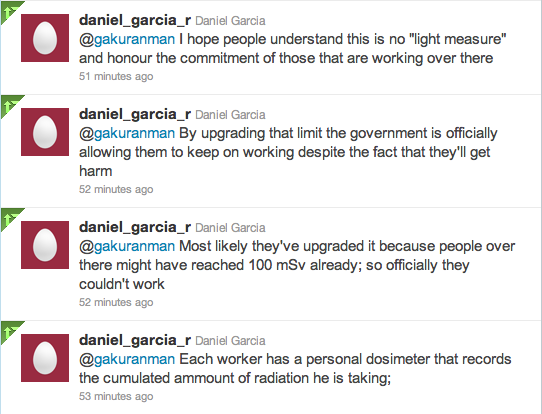
As he notes, workers likely carry a dosimeter that measures the accumulated dose for the year. Anything over this is deemed unacceptable and they will have to rest or do other jobs in environments that do not expose them to radiation until the annual limit has past. What the Japanese government has done is raise the limit (Daniel thinks it is likely because some workers have already passed the original 100mSv acceptable limit). 250mSv is a dangerous amount of radiation, and this radiation is likely to be absorbed in a short space of time over the duration of this episode. Make no mistake – these workers on the scene will have to undergo serious decontamination and may have have health defects, and they are doing all to protect us from a nuclear situation that could become much worse if the reactor fuel overheats. In past reports I have heard that there is a dedicated team of 50 people working at the plant. They have been dubbed the ‘Fukushima Fifty‘ in honour. 200 or so workers going in on rotating shifts of 50 at a time to minimise exposure, but even protective suits will not stop the radiation they will encounter. I think we would do well to realise the gravity of their situation amid all this fearmongering about the tiny amount of radiation that is reaching Tokyo. Of course, any radiation is dangerous, but currently outside the evacuation zone the levels are not harmful to human beings in short term spells.
http://www.npr.org/2011/03/17/134608139/radiation-a-concern-for-plant-workers-not-others
20.34 TBS is talking about the shortage of material goods. A lot of consumers in Tokyo and other affected areas are buying over what they need and hoarding due to fears there will be a shortage of food and because of a perceived lack of correct information. Minister for Administrative Reforms, Renho, has called on the country to be calm in their buying and to consider the situation. Another good example of why certain products are disappearing from the shelves was discussed. Notably milk is growing scarce because 3 of the 6 factories that make the milk cartons are based in Ibaraki and were damaged in the earthquake. (TBS)
19.30 For those who missed it, I was on BBC World Have Your Say very early this morning talking about the situation in Japan with a group of other people, including a scientist. The talk is pretty interesting, so if you’re interested, give it a listen. (My small section starts at 18 minutes 10 seconds in).
http://www.bbc.co.uk/blogs/worldhaveyoursay/
http://downloads.bbc.co.uk/podcasts/worldservice/whys/whys_20110316-1900a.mp3
19.16 Edano finally slept! A little internet meme. Currently over 300,000 views!
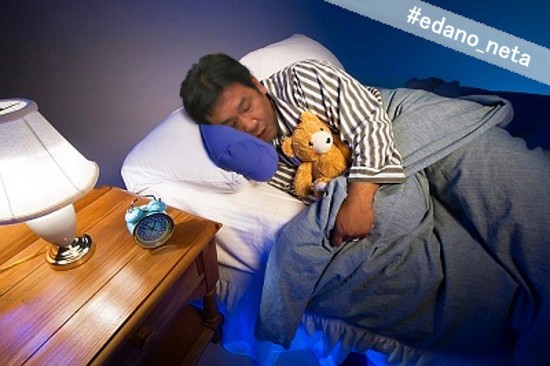
19.03 Chief Cabinet Secretary Edano live on television talking about the blackouts. The temperature has fallen over the last few days causing people to use their heaters. This has put extra stress on the already small amount of electricity available and there are concerns that it may cause unplanned electricity shortages. (TBS) As usual Edano is strong-spoken and in command. Perhaps he also got some sleep in the last few days. A few images uploaded by other people:


18.08 Twitter has screwed up and most people having stopped tweeting or seeing each other’s tweets. I hope it’s fixed soon. For now I’m using Yorufukurou.
Mountain climber Chris sent me a link to a Yomiuri article that explains what happened in the 8-9 hours that are missing from TEPCO’s radiation results. It explains that TEPCO’s employees accidentally disconnected the communications line between the main office and the nuclear power plant while performing construction work on the power lines in Tomioka, Fukushima prefecture .
Hmm… This sounds almost too convenient while the reactors at Daiichi were in a critical state last night. We now don’t know what the radiation readings during that time. I wonder if any other sources recorded it..?
http://www.yomiuri.co.jp/feature/20110316-866921/news/20110317-OYT1T00291.htm
16.08 Japan Probe has put together a good collection of links and videos that compare (and dissociate) the current situation at Fukushima to that of Chernobyl. Must read.
http://www.japanprobe.com/2011/03/17/comparing-chernobyl-fukushima/
15.48 TEPCO have *finally* released some some readings. Current radiation levels a the main entrance are 0.3mSv/h as of 11.00 this morning compared to 1.5mSv/h yesterday at 15.50. In front of the northern main office block they are 3.7mSv/h.
What puzzles me however is that there is a 9 hour gap between 15.50, March 16th and 00.30, March 17th where no radiation figures are given at all. This is very suspicious.
http://www.tepco.co.jp/cc/press/betu11_j/images/110317b.pdf
http://www.tepco.co.jp/cc/press/betu11_j/images/110316e.pdf
March 16th, for posterity.
March 17th, for posterity.
15.40 Current graphs with radiation levels in Fukushima and Tokyo.
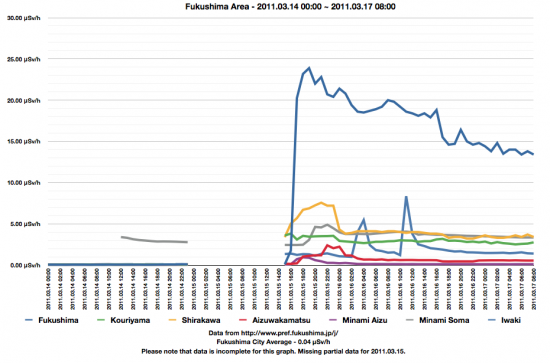
Above: Fukushima (various locations).
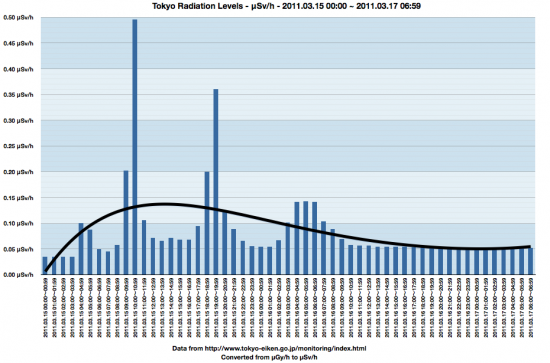
Above: Tokyo
15.36 Radiation levels in Fukushima prefecture are rather high. 65km to the north of the Daiichi plant, radiation levels in Fukushima city were 0.0139mSv/h (340 times higher than normal). Other figures for other towns around the plant were lower than this value but still worrying.
http://www3.nhk.or.jp/news/html/20110317/k10014733971000.html
15.26 The Japanese government has raised the acceptable limit for radiation exposure for on-site SDF and NPA workers from 100mSv to 250mSv for this particular earthquake due to the critical situation at Fukushima Daiichi nuclear power plant. The National Personnel Authority says that this is at the very top of the safe limit for which human beings can be exposed without health risks.
In other news, roughly 10,000 people who were evacuated from Fukushima and were thought to have been exposed to radiation were found to be clean. It was deemed not necessary to have to decontaminate anyone.
http://www3.nhk.or.jp/news/html/20110317/t10014736351000.html
http://www3.nhk.or.jp/news/html/20110317/t10014736661000.html
15.06 Latest. Earlier today the government finally implemented the cooling attempt they’d been planning. They instructed the National Police Agency (NPA) and Japanese Self Defence Force (SDF) to carrying out a rather difficult mission that involved dumping water on the overheating spent fuel storage pools at units 3 and 4, Fukushima Daiichi nuclear plant. Operating two CH74 helicopters, the SDF used a 7.5 tonne container to scoop up sea water and drop it onto the troubled units, prioritising unit 3, At the same time the NPA used a high pressure water truck to hose down the units from a safe distance.
Water was dropped 4 times from the sky, but the radiation readings taken before and after have not changed much. Measured from several hundred metres above, the radiation was roughly 3.7mSv and remained largely the same about an hour afterwards. Water has been reported in the pool at unit 4, but unit 3 is still in a serious condition and will be given priority. Units 5 and 6 only have a little more time before they reach a critical situation. There will not be any more water drops by helicopter today although cooling via the water truck will continue.
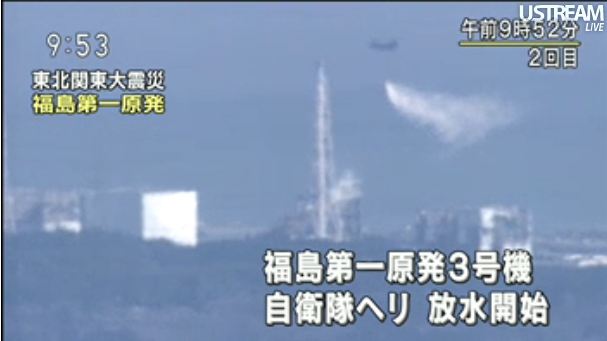
http://www3.nhk.or.jp/news/html/20110317/t10014729861000.html
http://www3.nhk.or.jp/news/html/20110317/k10014733231000.html
http://www3.nhk.or.jp/news/html/20110317/t10014734611000.html
http://www3.nhk.or.jp/news/html/20110317/t10014734091000.html
15.00 Image showing the effects of radiation on the human body that I translated now well over 150,000 views. I hope it helped clear up some of the sensationalism. If you didn’t see it yet, be sure to have a look.
14.57 Fantastic account of enduring the earthquake in Tokyo from a poignant father. Excellent read.
http://practicaluseful.com/?p=251
11.57 More Worst Case Scenario insight added from the UK Government’s Chief Scientific Officer Professor John Beddington. In summary, outside of 30km, there is very little risk. Even in Chernobyl, outside of the 30km radius there was no evidence to suggest that people had problems from radiation emitted. The people that will be seriously affected are the heroic workers battling at Fukushima’s Daiichi plant as I write. One thing I did note was that this analysis did not talk about the danger of a dry spent fuel pool which other sources are reporting could be very bad news.
It appears however that from this morning’s results that one of the containment vessels may be somewhat cracked. That’s new information that came through I think like 5 in the morning Japan time. The situation is still much the same. What they’re going to continue to try to do is keep the temperature low, keep the pressure within the containment vessels within those tolerance limits. That will involve very limited amounts of radioactive material going out. Now that’s what is I think is happening at the moment. Now the first thing to say about that is do we have any concerns now in terms of human health. Well the answer is yes we do, but only in the immediate vicinity of the reactors. So the 20 kilometre exclusion zone the Japanese have actually imposed is sensible and proportionate. If they extended out a little bit more to 30 kms, that is well within the sort of parameters that we would think are extremely safe.
Let me now talk about what would be a reasonable worst case scenario. If the Japanese fail to keep the reactors cool and fail to keep the pressure in the containment vessels at an appropriate level, you can get this, you know, the dramatic word “meltdown”. But what does that actually mean? What a meltdown involves is the basic reactor core melts, and as it melts, nuclear material will fall through to the floor of the container. There it will react with concrete and other materials … that is likely… remember this is the reasonable worst case, we don’t think anything worse is going to happen. In this reasonable worst case you get an explosion. You get some radioactive material going up to about 500 metres up into the air. Now, that’s really serious, but it’s serious again for the local area. It’s not serious for elsewhere even if you get a combination of that explosion it would only have nuclear material going in to the air up to about 500 metres. If you then couple that with the worst possible weather situation i.e. prevailing weather taking radioactive material in the direction of Greater Tokyo and you had maybe rainfall which would bring the radioactive material down do we have a problem? The answer is unequivocally no. Absolutely no issue. The problems are within 30 km of the reactor. And to give you a flavour for that, when Chernobyl had a massive fire at the graphite core, material was going up not just 500 metres but to 30,000 feet. It was lasting not for the odd hour or so but lasted months, and that was putting nuclear radioactive material up into the upper atmosphere for a very long period of time. But even in the case of Chernobyl, the exclusion zone that they had was about 30 kilometres. And in that exclusion zone, outside that, there is no evidence whatsoever to indicate people had problems from the radiation. The problems with Chernobyl were people were continuing to drink the water, continuing to eat vegetables and so on and that was where the problems came from. That’s not going to be the case here. So what I would really re-emphasise is that this is very problematic for the area and the immediate vicinity and one has to have concerns for the people working there. Beyond that 20 or 30 kilometres, it’s really not an issue for health.
[Q] You’ve said that at Chernobyl radioactive material went up to 30,000 feet, but you’ve also said that the worst case scenario here is for it to go up to 500 metres. Could you just explain why the worst case scenario here is much less than at Chernobyl?
[JB] Yeah, very much so. In Chernobyl, , first of all the top blew off the reactor and then the core of the reactor, the graphite which surrounds the core actually caught fire and burned for a very long time, so you had very, very, hot fire pushing all the material up in the normal sort of convection processes. Here, what will happen with the build up of pressure if the radioactive material interacted with the container floor and you would get a single explosion but it would not be a continued explosion. So that explosion would send material up to about 500 metres would be the sort of level we would expect. You know, it’s spurious accuracy, it might be 517 or 483 but that’s about it. And in terms of that, and couple that with weather, we still see absolutely no issue of material being taken at any critical level for human health beyond that 20 kilometres or so.
[Q] One confirmation, one question. Confirmation it sounds like from your assessment that it is coming on the basis of that your knowledge of this plant as opposed to information that’s coming from the Japanese Government. Concerns here are that information coming from either TEPCO or the Japanese government is not correct. Is my assumption correct, that you are basing what you know on the basis of your knowledge of this particular facility as opposed to any information you are getting from the Government? And the second part is, my own understanding is that the risks remain probably high for perhaps up to 10 days then they will begin to dissipate. But when can you anticipate that risks begin to dissipate?
[JB] OK in terms of the information we’re getting most of the information we’re getting is what the Japanese authorities have been putting into the appropriate international agencies. That’s the normal course of events. There may be merit if we can establish it in actually getting some direct information from them. But what they’re putting out is pretty comprehensive and it’s going into the appropriate international organisations. So the other point here is that in fact you know I want to sort of give some reassurance that you know even if you had a completely paranoid view that somehow the radiation was being concealed, you can’t do it, it’s monitored throughout the world. We know we can actually monitor exactly what the radiation levels are around there externally so it’s just not happening. You know, there is a degree of concern about whether the Japanese Government are actually giving all the information out , but in fact we are getting information through the international energy agencies and we do have pretty detailed knowledge of what these plants are like. And we’ve had input in from our health and safety executive colleagues who know these types of plants from the national nuclear laboratory and the Chief Exec of there has helped out with the SAGE group, has worked in Japan a few tens of kilometres from this particular site. So he knows those issues fairly well. So we’re pretty confident that’s what we’re getting.
[Q] Good morning. Couple of days ago the Japanese authorities predicted a 70% chance of another aftershock exceeding magnitude 7, and potentially another tsunami. If that were to happen and the emergency procedures that are taking place now, how does that affect your worst case scenario?
[JB] I think the worst case scenario would remain. The issue is basically that if they can’t, if for example, their attempt to cool fails, and if their attempts to keep the pressure in the containment vessel fails, then you would get an explosion. What I suppose, you know, in a reasonable worst case that that would happen in a single reactor, if you had a massive new influx of tsunami and so on, you move into a sort of relatively low probability event, but you might get more than one, but the point still remains that you would actually have no real concerns even if there were two rather than one explosions, they don’t multiply it up, it doesn’t mean that it goes up to 1,000 metres or anything like that. It’s still up to about 500 metres, it still is a relatively short duration and the key thing here also is wind direction. When does it happen? If the wind is taking material, is going out into the Pacific, it is not going to be a problem. It’s the combination, as it were, unhelpful weather, and an explosion that is twice that reasonable worst case scenario. If you had this sort of second tsunami so that people could not work and actually operate on the core then you would have a problem. But that would probably mean that you might get all three reactors go up. But again, I’d emphasise this would not affect the advice we are giving.
[Q] The next question, there’s a lot of concern in the community about the taking of iodine. At what point should iodine be taken and would you recommend people taking it proactively?
[JB] I think I know the answer to this, but I’m going to let Hilary or Lesley answer.
[HW] Actually the person I think would be answer that is, our HPA physician who knows a lot about these things, Nick Kent, are you on?
[NK] Yes, I am. I think I’ll answer it in two ways. The ways you may get exposed to radio iodine are either you inhale volatile radio iodine and that will only happen very close to the nuclear power plant itself, and we certainly do recommend where people are close to a nuclear plant when an accident occurs that they should take stable iodine to block iodine uptake to the thyroid in those circumstances. But there’s nobody close to the nuclear plant and that’s not a means by which there will be exposure here, and therefore that’s not, you know that is not a reason to take iodine in the case of yourselves living in Tokyo.
The second but most important way that people get exposed to radio iodine is that as the radio iodine settles into the environment, it gets incorporated into crops, it gets taken up into animals and it gets excreted into milk. And the problem in the case of Chernobyl which is where quite a number of cases of thyroid cancer were seen, it is now clear that the exposure pathway in the Russian Federation and Ukraine was ingestion of contaminated food, particularly milk. Now, we do not envisage the food chain as being an issue for you to take it up, and in any case, to use iodine to protect against the food chain would take long term administration of iodine, which would not be appropriate for other reasons, like the effects that would be on the thyroid. So I’ll just summarise. You’re not close to the plant so you’re not at an inhalation risk which is the principle use for iodine, and you we do not envisage you getting any radio iodine exposure through the food chain so again you know, no exposure therefore no need to use iodine as a countermeasure. Thank you.
[HW] Well I guess the issue with contamination will be specific to people who were working on site, and obviously there’ll be decontamination procedures in place for those people. Outside the 30 kilometre zone we wouldn’t expect contamination to be an issue to cause public health concerns.
[JB] OK and I think that’s the point, you know, it’s, the people who are going to get the biggest dose are the people who are actually working on the reactor trying to solve the emergency problem. They will, they will be completely screened by the Japanese authorities; they will be decontaminated in a whole series of mechanisms which are well understood by the nuclear industry. The people in the 20 kilometre zone are highly unlikely I reckon by now to actually have got any serious level of radioactivity. If they, actually the authorities, pick it up I would be very surprised if they do, they will actually do the decontamination. Basically these guys are not going to leave the plant and walk into their neighbourhood bar, they will be actually undergoing very severe very significant decontamination.
[Q] Good. A follow up to the question I asked about people going up to do volunteer relief work. Is it correct to say that if they are like 50, 60 kilometres from Fukushima they are in no danger from radiation?
[JB] I think that’s the case. You should be aware that Hilary and Lesley my two health colleagues are both nodding at my comment.
[Q] Just one quick question. You mentioned about contamination of food, I just wondered if there’s any risk of contamination of sea-food?
[JB] Lesley.
[LP] There is a possibility of that, yes. But the Japanese have very good monitoring programmes in place and they would understand it to be a potential exposure pathway and then sure, before they allowed people to consume seafood, they would provide advice and undertake monitoring.
http://ukinjapan.fco.gov.uk/en/news/?view=News&id=566811882
11.41 An explanation of the worst case scenario. I feel it’s important to be in the know just in case.
And just what is that worst-case scenario? “They’re venting in order to keep the containment vessel from failing. But if a core melts, it will slump to the bottom of the reactor vessel, probably melt through the reactor vessel onto the containment floor. It’s likely to spread as a molten pool—like lava—to the edge of the steel shell and melt through. That would result in a containment failure in a matter of less than a day. It’s good that it’s got a better containment system than Chernobyl, but it’s not as strong as most of the reactors in this country.”
Finally, Bergeron summed up the events so far: “Based on what we understand, the reactor has been shut down, in the sense that all of the control rods have been inserted—which means there’s no longer a nuclear reaction. But what you have to worry about is the decay heat that’s still in the core—that will last for many days.
“And to keep that decay heat of the uranium from melting the core, you have to keep water on it. And the conventional sources of water, the electricity that provides the power for pumps, have failed. So they are using some very unusual methods of getting water into the core, they’re using steam-driven turbines—they’re operating off of the steam generated by the reactor itself.
“But even that system requires electricity in the form of batteries. And the batteries aren’t designed to last this long, so they have failed by now. So we don’t know exactly how they’re getting water to the core or if they’re getting enough water to the core. We believe, because of the release of cesium, that the core has been exposed above the water level, at least for a portion of time, and has overheated. What we really need to know is how long can they keep that water flowing. And it needs to be days to keep the core from melting.
“The containment, I believe, is still intact. But if the core does melt, that insult will probably not be sustained and the containment vessel will fail. All this, if it were to occur, would take a matter of days. What’s crucial is restoring AC power. They’ve got to get AC power back to the plant to be able to control it. And I’m sure they’re working on it.”
http://www.scientificamerican.com/article.cfm?id=fukushima-core&page=2
10.54 Excellent point relayed on Twitter right now. Many of you may see pictures of Japanese people wearing surgical masks. These masks are very common in Japan and used for hayfever, fashion and of course, hypochondria. Some people will say they are using them to protect against radiation, but the reality is that they are a very normal part of life here. Please do not be startled by seeing people wearing them.
10.54 In case you are worried, you can check your distance from Fukushima using the tool below.
http://distancecalculator.globefeed.com/Japan_Distance_Calculator.asp
10.25 UK Embassy page again. I may have briefly overlooked it, but it seems the UK is also officially advising residents to remain 80km away from the Fukushima plants. May I remind everyone that Tokyo is about 200km away.
As an additional precautionary measure, British nationals are advised to remain outside an 80km radius of the Fukushima nuclear facility. This is in line with the advice issued by the US Government to its citizens. We urge British nationals to observe the advice being given by Japanese authorities, including the 20km exclusion zone around the Fukushima facility and to remain indoors, keep windows and doors closed and not to use ventilation if you are between 20km and 30km from the facility. If you are currently between 30km and 80km from the facility, we advise you to leave the area or take shelter indoors if you are unable to travel. For people within 80km of the Fukushima nuclear facility, please contact the Foreign Office Japan emergency hotline on +44 20 7008 0000 for further advice.
http://ukinjapan.fco.gov.uk/en/help-for-british-nationals/travel-advice
10.15 NHK source reports that a spokesperson from the White House said that the American recommendation for an 80km evacuation zone is based on advise from the Governmental Nuclear Regulatory Commission (NRC).
http://www3.nhk.or.jp/news/html/20110317/k10014727991000.html
09.47 Important. The US embassy has advised its citizens to remain at least 80km (50 miles) away from the Fukushima Daiichi nuclear power plant following independent radiation tests. Currently I have not come across any supporting evidence or radiation figures, but since the statement is on the embassy website, I consider it important enough to post. NHK has also release an article confirming the statement. Elsewhere I am hearing that radiation figures in Ibaraki are constant with yesterday and even falling. Trying to confirm. Stay tuned.
The United States Nuclear Regulatory Commission (NRC), the Department of Energy and other technical experts in the U.S. Government have reviewed the scientific and technical information they have collected from assets in country, as well as what the Government of Japan has disseminated, in response to the deteriorating situation at the Fukushima Nuclear Power Plant. Consistent with the NRC guidelines that apply to such a situation in the United States, we are recommending, as a precaution, that American citizens who live within 50 miles (80 kilometers) of the Fukushima Nuclear Power Plant evacuate the area or to take shelter indoors if safe evacuation is not practical.
We want to underscore that there are numerous factors in the aftermath of the earthquake and tsunami, including weather, wind direction and speed, and the nature of the reactor problem that affect the risk of radioactive contamination within this 50 mile (80 km) radius or the possibility of lower-level radioactive materials reaching greater distances.
Meanwhile, the U.K embassy has revised its position to recommend that Tokyo residents should consider leaving due to the disruptions in supply of goods and power. Their stance on the nuclear situation is still in line with Japanese authorities.
We advise against all non essential travel to Tokyo and north eastern Japan given the damage caused by the 11 March earthquake and resulting aftershocks and tsunami. Regarding the situation at the Fukushima nuclear facility, the most recent advice from the UK’s Chief Scientific Adviser remains that for those outside the exclusion zone set up by the Japanese authorities there is no real human health issue that people should be concerned about. This advice is kept under constant review. However, due to the evolving situation at the Fukushima nuclear facility and potential disruptions to the supply of goods, transport, communications, power and other infrastructure, British nationals currently in Tokyo and to the north of Tokyo should consider leaving the area.
http://japan.usembassy.gov/e/p/tp-20110317-01.html
http://public-blog.nrc-gateway.gov/
http://ukinjapan.fco.gov.uk/en/help-for-british-nationals/travel-advice
**End Live Updates** Okay all. I’m spent. Off to rest. Here’s to hoping they sort out that plant quickly and safely.
01.03 MEXT has just published the readings for Fukushima. The values are significantly higher than Ibaraki, but still within the safe range. They confirm the value I heard on NHK t.v earlier – the highest figure is 80uSv/h (0.08mSv/h).
Remember though, that a person has to be exposed to these values for one whole hour in order to receive the amount of radiation.
PDF here for posterity
http://www.mext.go.jp/component/a_menu/other/detail/__icsFiles/afieldfile/2011/03/16/1303726_04.pdf
http://www3.nhk.or.jp/news/html/20110317/k10014727991000.html
00.28 Important! A follower just pointed out to me that I haven’t been clear on talking about the radiation values. The values being given in the sources I’ve cited so far are in mSv/h or uSv/h.
What does this mean? It means that you’d have to be exposed to the corresponding level of radiation for one hour in order to receive that dosage.
In a previous update, I said the radiation level at 25km from the plant was 0.08mSv. I should have said 0.08mSv/h. What it means is that a person exposed to 0.08mSv/h would only accumulate 0.08mSv if they were exposed for 3600 seconds (1 whole hour). If they stood there for 3 minutes and 45 seconds (1/16th), they would receive 0.005mSv of radiation. One thing that is important to note, however, is that acquiring high amount of radiation in short periods of time is damaging to your health. (For example, accumulating 100mSv in a few days would post health risks).

A big thank you to tioguerra for pointing that out!
17th March, 2011
23.43 Here’s an anti-hoarding pamphlet somebody has made:
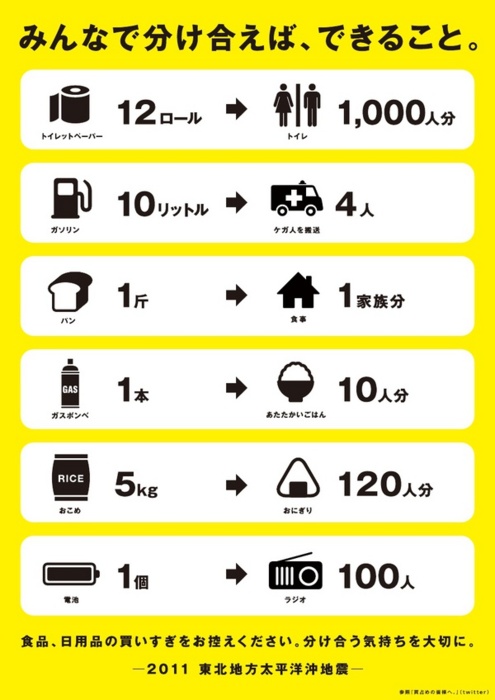
http://neetnik.tumblr.com/post/3897067824
23.13 The Ministry of Education, Culture, Sports, Science and Technology (MEXT) has published its own radiation figures. Worth taking a look. Here’s the latest as of 15.00 today. Values are in micro (uSv) sieverts – NOT milli sieverts (mSv). The values are tiny, as one would expect. Strangely though, the figures for Fukushima itself are missing. Here in Nagoya, values are about 0.04uSv – that’s 0.00004mSv/hour. (Remember for reference, our chest x-ray is 0.05mSv).
The figures for Ibaraki are a different story however. Embedded below. They’ve ranged between 0.0058mSv and 0.0015mSv. Still far lower than our x-ray.
本データは、1μGy/h(マイクログレイ毎時)=1μSv/h(マイクロシーベルト毎時)と換算して算出。
Incidentally, the conversion between Grays (Gy) and Sieverts (Sv) is generally a 1:1 conversion. This is what MEXT has used above. So if you see charts around the net with uGy values, you can assume it means uSv.
http://eq.yahoo.co.jp/
http://www.mext.go.jp/a_menu/saigaijohou/syousai/1303723.htm
23.03 Fleep.com continues providing visually appealing and clear graphs of the radiation levels. It’s great to see so many people pitching in where they can. The Fukushima graph (Iwaki city) is the most pressing right now:
22.37 Radiation levels are they were shown on television (NHK, if I recall correctly). They are in micro (uSv).
Another sticker was added after I took this screenshot. It showed levels of 0.08mSv at distances 25km from the Fukushima plants. I did not note when the reading was taken, nor for how long, but judging by TEPCO’s readings, I think we can assume it was the highest value and not for very long. To clarify, 0.05mSv is equivalent to a chest x-ray, so one wouldn’t want to be in an environment with 0.08mSv for long periods of time.
21.54 I’ve been looking into the damage done so far to the Fukushima Daiichi Nuclear Power Plant. Here’s the current situation.
Unit 1
Earthquake caused the cooling system to fail, resulting in partial meltdown of the nuclear fuel rods. Radioactive vapour was given off. On March 12th, a hydrogen explosion damaged the roof and forced the team to cool the nuclear core by pumping seawater inside.
Unit 2
The cooling system failed and for a period of time, the fuel rods were completely exposed. The outer housing of the unit was damaged in an explosion from unit 3 on March 14th. In the morning of March 15th, the sound of an explosion was recorded near the container surpression pool (pressure control system). Cannot rule out the possibility of a complete core meltdown. Sea water pumped in and water levels have risen to a certain extent.
Unit 3
Cooling system was lost on March 13th – possibility of meltdown. Radioactive vapour released into the air and sea water pumped into the reactor. Hydrogen explosion on March 14th – damage to the outer building. 400mSv recorded close the the reactor on March 15th. White smoke was observed pouring out of the unit on March 16th leading to the possibility that the nuclear reactor container is damaged.
Unit 4
Undergoing inspection. A fire was recorded in the reactor housing on the morning of March 15th. Possibility there was a hydrogen explosion due to the spent fuel rods. Temperature of the spent fuel pool rises extremely high. Workers unable to check the water gauge or pump in sea water. Another fire was recorded on the 16th (today). Cannot rule out the possibility of a critical situation. Team considering spraying boric acid on the unit.
Unit 5
Undergoing inspection. Spent fuel pool is warmer than usual.
Unit 6
Undergoing inspection. Spent fuel pool is warmer than usual.
Plant 2, Units 1-4
All units automatically stopped at the time of the earthquake. Unit 3’s cooling system was stopped immediately after the earthquake. Units 1,2 and 4 are currently stable and cooling is stopped as of March 15th.
There are some very good satellite images from Digital Globe available to download that clear show the progression of the damage.

Here’s the plant after the earthquake and tsunami, but before any explosions.
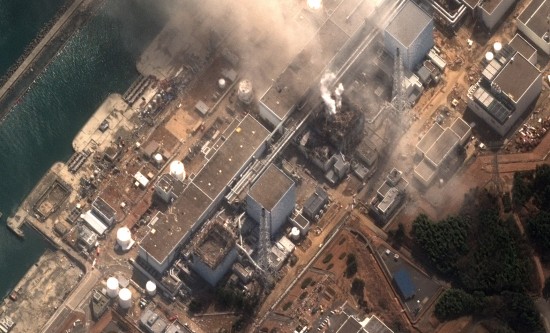
Here’s the plant after the explosions of reactors of 1 and 3.

Here you can see the damage from fire on unit 4 and the white smoke pluming out of unit 3. There is also smoke coming out of a hole in unit 2.
Damage to Daiichi Reactor (pdf)
Damage to Japan (pdf)
http://www.47news.jp/CN/201103/CN2011031601000925.html
http://www.digitalglobe.com/index.php/27/Sample+Imagery+Gallery
19.54 TBS announcers were just talking about the international decision to upgrade the Fukushima incident to a level 6 on the IAEA scale of nuclear incidents. They note that even moving it up the scale does not necessarily mean that there is an increased risk to people’s health at the current time. Also, in their opinion, Chernobyl was far and away a very high level 7 incident, something which Fukushima will not approach.
However you take this, the fact that an independent American team of scientists has arrived to monitor the situation and the fact that the planned helicopter cooling solution was abandoned to high radiation levels in the air both suggest that the situation at Fukushima is getting worse. It is not my intention to fear monger and I am no expert on nuclear matters, despite how much I’ve learned over the past few days, but in my opinion the situation is worsening more than the government is admitting. Care would be prudent.
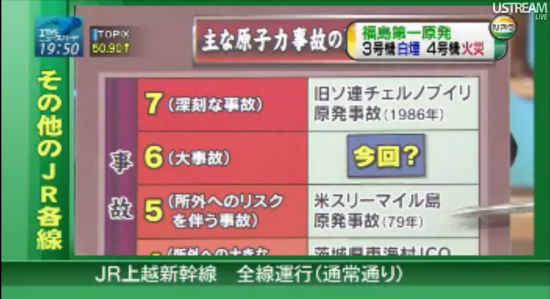

http://www-ns.iaea.org/tech-areas/emergency/ines.asp
19.34 The Emperor of Japan gave a surprise speech, addressing the nation from a video broadcast. This is extremely rare, reserved for times of great crisis or war. Kyodo News has a good summary, and you can watch the video yourself below.
Emperor Akihito said in an unprecedented video message Wednesday that he is hurt by the devastation caused by last Friday’s earthquake and ensuing tsunami, and expressed hope that the people in Japan will overcome the challenges they face by caring for each other.
”I am deeply hurt by the grievous situation in the disaster-hit areas,” the emperor said in a video footage released by the Imperial Household Agency. ”I sincerely hope that people will overcome this unfortunate time by engendering a sense of caring for other people.”
It is the first time the emperor has appeared in a video message to convey his feelings to the public. The footage was released following strong wishes by the emperor and Empress Michiko to directly communicate with the public, as they are very concerned about the extensive and grave damage wrought by the earthquake, according to the agency.
”I was greatly moved by the braveness of the survivors who are encouraging themselves in trying to live on through this enormous disaster,” the emperor said.
”I hope that those affected by the earthquake will not give up hope and strive to survive, while taking care of their health,” he added.
The emperor also called on each citizen to continue to have sympathy for the disaster-hit areas and remain supportive of their road to recovery.
In addition, the emperor expressed gratitude to the relief efforts made by Japan’s Self-Defense Forces, the Japan Coast Guard, police, firefighters and rescue workers from in and outside Japan.
Emperor Akihito and Empress Michiko have sent relief money to Iwate, Miyagi, Fukushima, Ibaraki and Chiba prefectures, which were severely hit by the earthquake and tsunamis, the agency said.
The imperial couple have voluntarily cut electricity at their residence in Tokyo for two hours daily as they want to share the hardship experienced by the people under the power rationing measure taken by electric companies, the agency said.
==Kyodo
http://www.youtube.com/watch?v=Y7PNP-mYDkM
http://english.kyodonews.jp/news/2011/03/78612.html
18.54 Latest updates. The government had been planning to use a helicopter to approach the troubled reactor 3 at Fukushima nuclear plant 1. Levels of radiation on the ground made it too dangerous too approach and the decision was made to drop water from above to try and cool the overheating reactor. However, the levels of radiation being released into the sky were well over the limit of 50mSv, so the attempt had to be abandoned.
The latest press conference given by Chief Cabinet Secretary Edano (who looks like he hasn’t slept in days) emphasised the current low levels of radiation and its non-threat to residents living outside the 20km evacuation radius. Edano called for material supplies and good to be delivered to those people in stricken areas, particularly those in the 20-30km radius who have been told to stay indoors. The current value at the 20km border is 0.33mSv. It’s a value that, if exposed to for a whole year for 24 hours a day, could lead to problems, but for a few days it will not cause harm to human health.
An American team has been brought in to conduct independent measurements of the radiation levels at Fukushima. This is ‘in order to help Japan during this difficult time and ensure the safety of American citizens living in Japan. Not because we do not believe the Japanese figures. Furthermore, the Institute for Science and International Security (ISIS) has determined that the situation oat Fukushima is no longer a level 4 incident. They have upgraded it to level 6, with the possibility of it worsening to level 7, the same level as the Chernobyl incident many years ago.
http://www3.nhk.or.jp/news/html/20110316/t10014720721000.html
http://www3.nhk.or.jp/news/html/20110316/k10014719331000.html
http://www3.nhk.or.jp/news/html/20110316/k10014719551000.html
http://isis-online.org/isis-reports/detail/isis-statement-on-events-at-fukushima-daiichi-nuclear-site-in-japan/
16.01 Latest TEPCO figures shows discrepancies to what NHK reported earlier, but only by a little. At 10.45, 6.4mSv was recorded at the entrance to plant 1 and at 00.30 there was 10.8mSv. By 01.30 this value had again fallen to 2.5mSv. Incidentally, at plant 2, the current levels are still very low and not problematic at 0.029mSv.
Plant 1 – http://www.tepco.co.jp/cc/press/betu11_j/images/110316c.pdf
Plant 2 – http://www.tepco.co.jp/cc/press/betu11_j/images/110316b.pdf
Backup of pdf file for posterity.
15.41 A small victory for tweeters. Aside from myself, there is a crew of dedicated people all on Twitter translating and posting the latest information about events unfolding in Japan. Give this Japan Times article a read and say thank you to them for their tireless efforts.
http://search.japantimes.co.jp/cgi-bin/nc20110316a1.html
15.00 Japan Times has published a useful document containing links to many embassies and municipalities, as well as health advice and ways to donate. Must read.
http://www.japantimes.co.jp/news/emergency-assistance.html
14.47 Google has created a map showing all current blackout zones. Just stick in your postcode and find out which group you are in. There is also a schedule, but check the television and your local news for word on when the blackouts are, as the times seem to change.
http://www.google.co.jp/intl/ja/crisisresponse/japanquake2011_power.html
https://sites.google.com/a/creco.net/teiden-calendar/
13.23 Some nice, clear illustrations have emerged from an English Yomiuri article showing the current problem reactor 2, as well as the evacuation zone and more confirmation of the effects of radiation that I posted yesterday. The article is worth a read. Here is a small chunk that clarifies a few things:
TEPCO said the No. 4 reactor was out of operation for regular checks when the magnitude-9 earthquake hit the Tohoku region Friday.
However, the earthquake knocked out electricity to the reactor needed to circulate cooling water in the pool that temporarily stores spent nuclear fuel. As a result, residual heat from nuclear fuel rods raised the water temperature in the pool from the ordinary level of about 40 C to 85 C, TEPCO said.
“Lower water level in the pool exposed tubes [encasing the fuel rods], which reacted with steam, likely generating hydrogen and causing an explosion,” said Tetsuji Imanaka, assistant professor at Kyoto University Research Reactor Institute.
A total of 783 spent nuclear fuel rods were stored in the pool. At the Fukushima No. 1 nuclear power plant, three reactors–Nos. 4, 5 and 6–were out of service for regular inspections. About 300 to 500 spent nuclear fuel rods are also kept at the Nos. 1, 2 and 3 reactors.
The explosion at the No. 2 reactor is believed to have damaged the suppression pool. The blast was heard at 6:14 a.m. at the No. 2 reactor, whose cooling functions had already been deteriorating. Pressure inside its suppression pool dropped from the normal level of three atmospheres to one atmosphere, according to TEPCO.
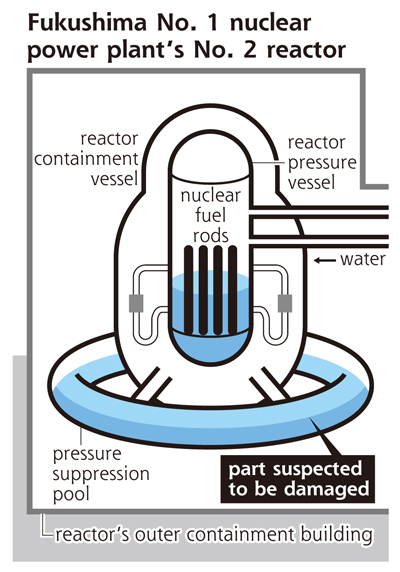
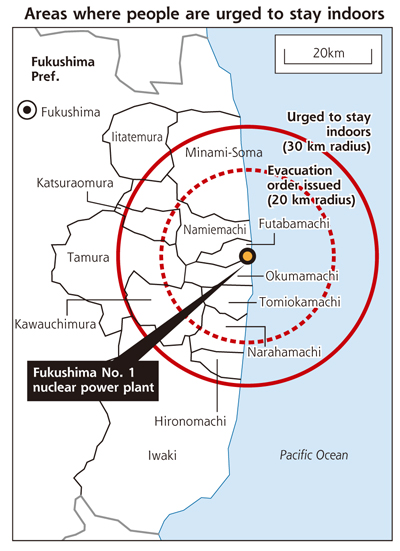

http://www.yomiuri.co.jp/dy/national/T110315004749.htm
13.23 Apologies about the gap. I lost my live stream feed and the was a lot of confusion about the statistics that came out of the latest press conference. There’s still a lot of ambiguity and I don’t doubt that many foreign news outlets will pick up the most shocking and disproportionate of these leaked figures, but here’s the latest from NHK news.
The Nuclear and Industrial Safety Agency has reported that radiation was emitted from what is thought to be unit 2 at Fukushima nuclear plant 1. The Suppression Pool (pressure control room) was damaged in a third explosion recently and it is thought that the increase in radiation was due to that. At 10.40, NISA recorded 10mSv/hour at the entrance of the plant, but 30 minutes later this value had fallen to 2.7mSv/h. The workers on site had retreated at the time of the large radiation release, but went back in after it fell again. It was suggested that the radiation increase was due to the white smoke coming out of unit 3 earlier this morning, but TEPCO said it was likely due to unit 2.
http://www3.nhk.or.jp/news/html/20110316/k10014710431000.html
10.24 White smoke recorded pouring out of Fukushima nuclear plant 1 (via NHK, live video)
10.07 Useful graphs showing the earthquakes and radiation levels recently. As you can see, yesterday there were two spikes of 11mSv and 8mSv at the entrance of the plant. It is unknown what the radiation levels were inside next to the reactors.
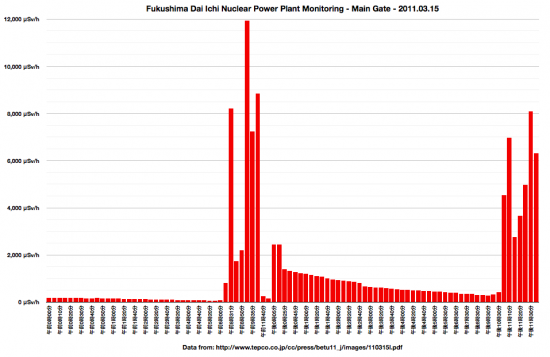
Earthquakes since last Friday when Tohoku was hit with the M9.0 quake.
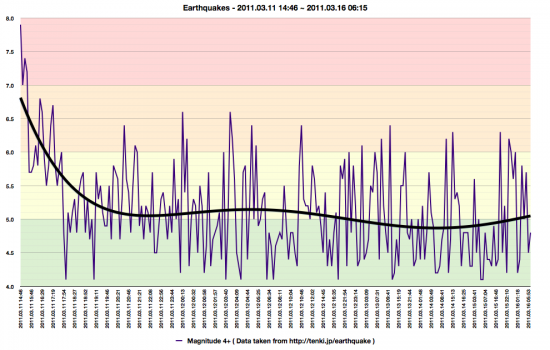
09.56 More moving pictures from scenes in the north. There is a serious shortage of basic necessities right now, including water, gas petrol, blankets, batteries, medical supplies, feminine products, baby formula, adult hygiene garments (etc.)
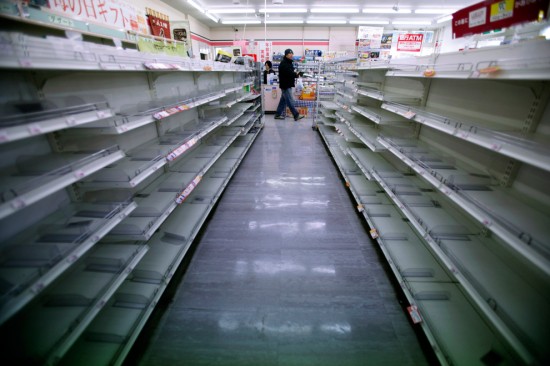
http://www.2hj.org/index.php/news/send_us_food_and_supplies/
http://www.boston.com/bigpicture/2011/03/japan_-_new_fears_as_the_trage.html
09.24 Latest. A few things happened while I was sleeping. Thankfully nothing too major, but I suppose that is all relative – there was another fire in the spent fuel pool in unit 4. Mutantfrog was up all night doing a stellar job of bringing updates, so I’ll refer you to his post, but in brief, here are the main points.
It was questioned whether or not the team trying to cool the reactor could use a helicopter to dump water on it. Apparently the holes in the outer building of unit 4 are not large enough to allow efficient delivery of water, nor are they over the spent fuel pool. Unfortunately, the holes are large enough to allow radiation leakage. The temperature sensor in the pool has also failed after going above 84 degrees C.
TEPCO have released another update with readings. As of 23.30, they had spiked again to 8mSv. This is similar to the 11mSv readings recorded at the entrance to the plant yesterday when 400mSv was recorded between the reactor buildings. I don’t know if we can assume that means there were again high levels of radiation between the buildings, but it seems reasonable to think so.
There are also reports that the fuel rods in reactors 1 and 2 may be damaged as that the water levels in the storage pool at unit 5 is low.
As of this morning, a fire re-started in the spent fuel pool of unit 4 but has since been extinguished as of 06.15 (via NHK t.v).
http://www.mutantfrog.com/2011/03/15/radiation-safety-update/
http://www3.nhk.or.jp/news/html/20110316/k10014704841000.html
http://www.tepco.co.jp/cc/press/betu11_j/images/110315l.pdf
http://www3.nhk.or.jp/news/html/20110316/k10014705561000.html
http://www3.nhk.or.jp/news/html/20110316/k10014705481000.html
**End Live Updates** Okay all. I’m signing out once again. Here’s to a peaceful night. See you all tomorrow.
00.51 Some lovely pictures here drawn by various artists in support of the great people working hard to get Japan out of this disaster. As a mere blogger, my deepest respects go out to the people on the scene saving people from the wreckage and fighting to control the situation at the nuclear plant. They truly are very brave.

http://matome.naver.jp/odai/2130010013148449401
March 16th, 2011









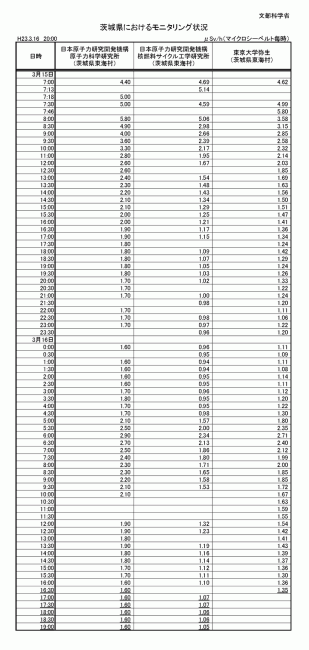
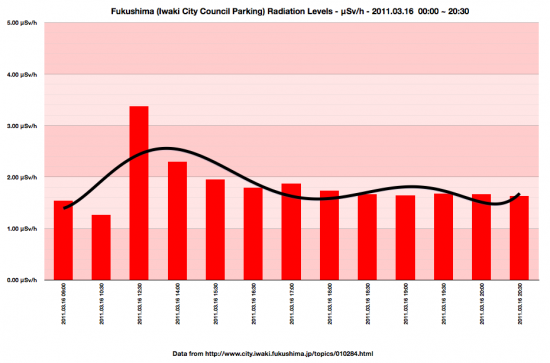
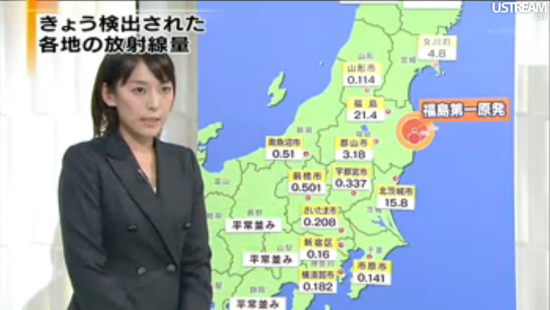
2 comments on “Great Tohoku Earthquake 3”